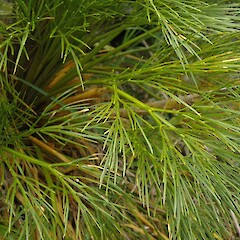Aciphylla multisecta
Synonyms
None
Family
Apiaceae
Flora category
Vascular – Native
Endemic taxon
Yes
Endemic genus
No
Endemic family
No
Structural class
Herbs - Dicotyledons other than Composites
NVS code
The National Vegetation Survey (NVS) Databank is a physical archive and electronic databank containing records of over 94,000 vegetation survey plots - including data from over 19,000 permanent plots. NVS maintains a standard set of species code abbreviations that correspond to standard scientific plant names from the Ngä Tipu o Aotearoa - New Zealand Plants database.
ACIMUL
Chromosome number
2n = 22
Current conservation status
The conservation status of all known New Zealand vascular plant taxa at the rank of species and below were reassessed in 2017 using the New Zealand Threat Classification System (NZTCS) – more information about this can be found on the NZTCS website. This report includes a statistical summary and brief notes on changes since 2012 and replaces all previous NZTCS lists for vascular plants.
Please note, threat classifications are often suggested by authors when publications fall between NZTCS assessment periods – an interim threat classification status has not been assessed by the NZTCS panel.
- Conservation status of New Zealand indigenous vascular plants, 2017 . 2018. Peter J. de Lange, Jeremy R. Rolfe, John W. Barkla, Shannel P. Courtney, Paul D. Champion, Leon R. Perrie, Sarah M. Beadel, Kerry A. Ford, Ilse Breitwieser, Ines Schönberger, Rowan Hindmarsh-Walls, Peter B. Heenan and Kate Ladley. Department of Conservation. Source: NZTCS and licensed by DOC for reuse under the Creative Commons Attribution 4.0 International licence.
2017 | At Risk – Declining | Qualifiers: DP, RR, Sp
Previous conservation statuses
2012 | At Risk – Naturally Uncommon | Qualifiers: RR
2009 | At Risk – Naturally Uncommon
2004 | Sparse
Distribution
Endemic. New Zealand: South Island (central Canterbury and Westland south to Fiordland).
Habitat
High altitude alpine (> 1300 m a.s.l.) on rock ledges, cliff faces and in or around seepages, or below snow melts.
Detailed description
Short, tufted herb forming patches up to 250 × 400 mm. Rootstock simple or branched. Leaves 60–100 mm, rigid, 3-pinnatisect. Sheath up to 50 × 25 mm, deeply ribbed; margins membranous. Stipules 30–50 mm long, 1–2–(3)-pinnate, tapering, on short to very short ligules, pungent. Petioles up to 150 mm long, rather stout and rigid, concavo-convex; margins thickened. Internodes 15 mm long. Primary pinnae 4–8 pairs; secondary 2–4 pairs; tertiary rather slender, almost filiform, 20–40 × 1 mm, apex pungent. Stems of female plants stout, 30 mm long, with inflorescence up to 150 mm long. Bract-sheaths chartaceous, c. 40 × 10 mm, including short ligule; stipules acicular, up to 10 mm long; lamina 2–3-pinnate, 40 mm long, on petioles up to 10 mm long. Umbels numerous, forming a dense globose panicle 60–100 mm diameter. Primary rays up to 40 × 1 mm, grooved. Umbellules numerous, up to 30 mm diameter, on rather slender rays. Fruit c. 3 mm long, narrow; mericarps 4–5-winged.
Similar taxa
Aciphylla multisecta is perhaps most closely allied to A. divisa and A. dissecta, species from which it differs by possessing simple, 1–2–(3)-pinnate stipules 30–50 mm long, and stout, rather rigid petioles that are 80–150 mm long, and by its densely compacted, subglobose panicle. Aciphylla is seriously in need of revision, using modern techniques. Until such time as such a revision is completed, the relationships and distinctions between many of the taxa accepted by Flora of New Zealand Volume I, will remain unclear.
Flowering
November–December
Flower colours
White
Fruiting
November–January
Life cycle
Winged schizocarps are dispersed primarily by wind (Thorsen et al., 2009).
Propagation technique
Difficult—should not be removed from the wild
Threats
Unlikely to be threatened. However it is known from very few collections and does not seem to be that common where it has been found. Partly this perception may be due to the fact that it favours high elevation cliff habitats that are not frequented by botanists but it does seem to be scarce and sparsely distributed over large parts of apparently suitable habitat, and this appears to be a naturally rather than induced pattern.
Etymology
aciphylla: From the Latin acicula ‘needle’ and the Greek phyllum ‘leaf’, meaning needle-leaf.
multisecta: Many divisions
Attribution
Fact sheet prepared for NZPCN by P.J. de Lange 1 February 2004. Description adapted from Allan (1961).
References and further reading
Allan HH. 1961. Flora of New Zealand, Volume I. Indigenous Tracheophyta: Psilopsida, Lycopsida, Filicopsida, Gymnospermae, Dicotyledones. Government Printer, Wellington, NZ. 1085 p.
Thorsen MJ, Dickinson KJM, Seddon PJ. 2009. Seed dispersal systems in the New Zealand flora. Perspectives in Plant Ecology, Evolution and Systematics 11: 285–309. https://doi.org/10.1016/j.ppees.2009.06.001.
NZPCN Fact Sheet citation
Please cite as: de Lange, P.J. (Year at time of access): Aciphylla multisecta Fact Sheet (content continuously updated). New Zealand Plant Conservation Network. https://www.nzpcn.org.nz/flora/species/aciphylla-multisecta/ (Date website was queried)





